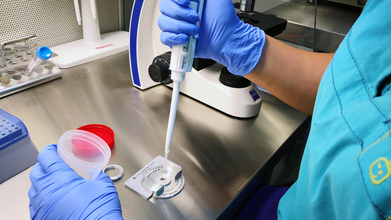- Health Conditions A-Z
- Health & Wellness
- Nutrition
- Fitness
- Health News
- Ayurveda
- Videos
- Medicine A-Z
- Parenting
- Web Stories
Do Dads Experience Postpartum Depression?

Credits: Canva
By now, we all must be aware of how a mother's body changes during and even after pregnancy. What comes next is a challenging phase, called postpartum. However, it is not just the mothers, but dads too go through postpartum depression. As per the UT Southwestern Medical Center, 1 in 10 dads struggle with postpartum depression (PPD) and anxiety. According to a 2019 study published in Innovations in Clinical Neuroscience, a peer reviewed journal providing evidence-based information, titled Postpartum Depression in Men by Jonathan R Scarff defines postpartum depression as an episode of major depressive disorder occurring soon after the birth of a child. While it is frequently reported in mothers, but can also occur in father. However, there is no established criteria for this in men, although it could present over the course of a year, with symptoms of irritability restrict emotions, and depression.
Why Do Dads Experience PPD?
Fathers can also experience postpartum depression (PPD) due to various factors, including a history of depression, relationship conflicts, financial stress, and maternal depression. Sleep deprivation and disrupted circadian rhythms, known to affect maternal mental health, may also contribute to PPD in men. Additionally, hormonal changes during and after pregnancy play a role. Studies suggest that lower testosterone levels in new fathers reduce aggression and enhance responsiveness to a baby’s cries, while increased estrogen levels promote more engaged parenting. However, these hormonal shifts can also increase vulnerability to depression. Low testosterone is directly linked to depressive symptoms, and imbalances in estrogen, prolactin, vasopressin, and cortisol may hinder father-infant bonding, further exacerbating PPD symptoms.
In fact the study also goes on to note that fathers can experience prenatal depression like mothers too. While it depends on the kind of environment they are in, here are some of the common reasons why dads feel this way:
Hormonal Changes: As per a 2014 study published in the American Journal of Human Biology, titled Prenatal hormones in first-time expectant parents: Longitudinal changes and within-couple correlations, showed that fathers experience hormonal changes during and after their partner's pregnancy. The main reason is the decline in testosterone.
Feeling Disconnected: While dads also want to be part of the newborn experience, the baby usually spends most of the time with the mother. It may make them feel like they are on the "outside".
Other reasons include the pressure that a father feels. Parenting is not easy, it adds on to financial pressure, and this thought could also lead to depression. Especially, if depression runs in father's family, he is more likely to feel depressed with these changes around him. Most new parents underestimate the role lack of sleep plays in their lives. Staying up all night trying to get your baby to eat or sleep can leave you feeling sleep deprived, which could be one of the reasons why the father too may feel tired and depressed.
What Can Be Done?
The American Academy of Pediatrics recommended that postpartum depression screenings not be solely the responsibility of obstetrician, and it must be done by pediatricians too to incorporate maternal health. However, fathers too should go for such screenings. In fact, in 2020, an editorial in the Journal of the American Academy of Pediatrics called on pediatricians to assess the mental health of all new parents regardless of gender.
The ray of hope here is that more and more people are talking about it and are able to recognize the depression dads also go through. The change is not just for moms, but also for dads, thus it is important that they also are taken care of.
Children Aren't Distracted By Nature, It's In Their Biology: Research Shows Why Their Attention Span Is Less

(Credit-Canva)
Children are known for hopping from one activity to the next, often when they should be focusing on just one thing. This is a common experience for parents and teachers. A new study suggests that this behavior is not just because kids are naturally curious. Instead, the real reason has a lot to do with the way their younger brains are still growing and working.
Children have a characteristic less attention span, and many people believe that it is simply because the children don’t find it interesting enough, however the study proved that this is not true. Published in the Journal of Experimental Psychology: General, researchers discovered that children's ability to stay focused on one task is limited because their working memory is not yet fully developed.
Why Do Children Have Less Attention Span?
Working memory is like the brain’s temporary notepad, it holds information needed to complete a task. When this memory gets overloaded, children can't stay "locked in" on a single job.
Researchers at Ohio State University essentially forced adults to behave like young kids during a task. They found that when an adult's working memory was filled up, their attention scattered, and they started acting just like young children.
To create the "kid-like" condition, some of the adults were asked to do a second, very difficult task at the same time as playing the candy game. This second task required them to intensely focus on a screen full of numbers and immediately shout out whenever they saw two odd numbers appear right after each other.
This extra mental effort, or load, completely soaked up their working memory, making it much harder for them to stay focused on finding the best candy character.
How Do People Concentrate?
The study included 40 five-year-olds and 71 adults who played a computer game. In the game, participants collected virtual candy from four cartoon characters. Each character always gave a different, fixed amount of candy (1, 2, 3, or 10). The goal was to figure out which character gave the biggest reward.
Some of the adults were given a second, demanding task to do at the same time: they had to watch numbers streaming by and call out when two odd numbers appeared in a row. This extra mental load made it much harder for them to focus on the candy game.
What Causes Scattered Attention In Kids?
Everyone, including the children and the distracted adults, was able to figure out which character gave the largest candy reward. However, the adults whose memory was overloaded, just like the young children, kept switching between characters instead of sticking to the best choice.
Researchers explained noted that this scattered attention happened even when participants knew the correct answer. The finding suggests that what we see as simple distraction in kids might actually come from a brain that is still developing.
The results change how we should view a child's attention span. They suggest that a child's natural tendency to switch focus might actually be a good thing, helping them learn in ways that are more flexible and adaptable than adults. It's not a weakness. This vital research could help teachers and parents create new teaching methods that work with a young child's natural way of learning, instead of always trying to make them concentrate against their developing brain's natural tendencies.
Fact Check: Semen Production Means You Have Healthy Sperms, Here's What The Doctor Says

Credits: Canva
Men's health is a topic often not talked about, however, it is as important as any other health related topics that are addressed more frequently. This is the case especially when it comes to men's reproductive health. While there has a been a lot of studies around semen production and what makes a sperm healthy, there are still many myths around it.
To burst one of such myths, we spoke to Dr Beena Muktesh, Senior IVF Expert at Motherhood Hospital, Gurugram. We asked her whether there was any truth in the claim that semen production is linked to healthy sperm.
Dr Muktesh points out that while sperm-related problems are rampant in men, many men still assume that producing semen automatically indicates fertility. "However, it is a myth that needs to be addressed." She says that there is a need to understand the difference between the two.
What Is Semen? How Does It Tell Whether The Sperm Is Healthy?
Semen is a fluid that is released during ejaculation. It contains sperm and other substances from the male reproductive organs. The sperm is around 1 to 5% of the semen. The rest of it is a liquid called seminal plasma, this includes water, proteins, enzymes, and nutrients like fructose for energy. It Is important for reproduction by helping sperm reach and fertilize the egg. "Healthy semen is pivotal when it comes to male fertility. However, a common myth among men is that if they ejaculate normally, their sperm must be healthy and fertile," she points out.
The doctor says that while semen production is sign that the reproductive system is functioning, it may not guarantee that the sperm it contains are capable of fertilizing an eff.
Dr Muktesh says, "Fertility depends not just on the presence of sperm but on their count, motility or movement, and morphology, or shape. Though many women do not know about this fact and continue to struggle in silence."
Semen that appears normal is volume, color and consistency, could still contain sperm that are low in number. They could move poorly, or have structural abnormalities, pointed out the doctor. "These factors impact the ability of sperm to reach and fertilize an egg, making conception difficult even if ejaculation occurs regularly."
The doctor suggests that men must undergo a semen analysis to evaluate their fertility. The analysis will be able to tell the number of sperm in a given volume of semen.
"Low count can reduce the chances of fertilization. The sperm motility will be checked to know how the sperm will move. Poor motility means sperm may struggle to reach the egg. The expert will also pay attention to the sperm shape and structure. Abnormal shapes can affect the ability to penetrate and fertilize the egg, and make conception challenging," she points out.
There are also other factors like the semen pH, volume, and white blood cell presence that could be monitored to detect infections or other underlying concerns. This is why it is important to get the analysis done and not just assume, she points out.
"Awareness and early evaluation allow timely intervention, increasing the chances of conception and promoting informed decisions about reproductive health. So, men, consult the expert without any delay and know about your sperm health status for healthy conception," she says.
Why Snatching the Phone May Not Be the Ultimate Parenting Tip for Teens

It’s almost a reflex action now - your teen seems distracted, moody or defiant and the first thing you reach for is their phone. Many parents believe that once the phone is gone, their child will start behaving better, focusing more and feeling calmer. But psychologists say this approach may be oversimplifying a complex emotional landscape.
The Real Issue: Teens Want to Be Understood, Not Controlled
Teenagers today are navigating a world far more layered than the one their parents grew up in. Their phones are not just gadgets, they are extensions of their identity, their social life and even their coping mechanisms. When parents link every behavioural problem to 'too much screen time' teens feel misunderstood and invalidated.
Also Read: Popcorn Brain: Is This Syndrome Behind Your Difficulty Concentrating? Experts Explain
“I am tired of being told that if I stop using my phone, I will feel better. My phone isn’t the problem, it’s how I connect with friends and keep up with what’s happening around me. Why should the rules be different for adults and for us?" says 16-year-old G. Kaur
This sentiment echoes across many teenage households - the need to be heard rather than judged. Their brains are still developing, firing signals of independence and identity formation, which often clash with parental control.
Why Parents React the Way They Do
For many parents, taking away the phone feels like the only available disciplinary tool. “Whenever I feel helpless about my son’s behaviour, my instant reaction is to taunt him about his phone usage or take it away,” admits one mother. “I know it is not right, but I don’t know what else to do. We grew up without phones and turned out fine but today’s kids just can’t seem to focus.”
This response, psychologists say, stems from fear and frustration. The digital world is unfamiliar territory for many parents, and snatching the phone feels like regaining control. But in reality, it often deepens the disconnect between parent and child.
Also Read: What Are Kratom And Kava, The Controversial Ingredients In ‘Feel Free’ Drinks?
What Psychologists Recommend Instead
First and foremost, understand the role of the phone. For teens, phones serve as social lifelines, a place where they explore identity, friendship and belonging. Dismissing that entirely can make them feel isolated. So instead of taking the phone away, have open conversations about how and why they use it.
Next focus on connection, not control. Rather than imposing blanket bans, set boundaries. For instance, agree on screen-free times during meals or before bed but let your teen be part of the decision-making. This gives them a sense of respect and control.
Also, look for the real reason behind behaviour. Irritability, withdrawal or lack of focus may not always be caused by phone use. These could be signs of stress, anxiety or emotional overwhelm.
Model healthy digital habits yourself. Teens mirror adult behaviour. If they see you constantly checking emails or scrolling late at night, they will assume it’s normal.
Keep an open communication. Teens respond better to empathy than authority. Simple statements like “I understand it’s hard to disconnect, even for me sometimes” or “I want to know what’s stressing you out” can make way for honest conversations.
In the end, parents need to understand that phones are not the enemy, disconnection is. When parents focus solely on controlling screen time, they risk missing the deeper emotional needs of their teens. Instead of snatching the phone, try reaching for understanding.
After all, the goal isn’t to raise a child who lives without a phone, it’s to raise one who can live well with it.
© 2024 Bennett, Coleman & Company Limited

